I think the facet approach is fine:
library(ggplot2)
library(gtable)
library(grid)
df <- data.frame(main.cat = c("A", "A", "B", "B", "B", "C"),
second.cat = c("a1", "a2", "b1", "b2", "b3", "c1"),
value = c(2, 3, 4, 2.5, 1.5, 2.3))
p = ggplot(data = df, aes(x = second.cat, y = value)) +
geom_point() + facet_grid(.~main.cat, space = "free_x", scales = "free_x") +
theme(strip.background = element_rect(fill = NA))
But if you want something closer to the excel look, one approach is to use gtable functions to extract the strip and insert it below the tick mark labels, then insert some boundary lines between the major categories. Note that the code below is specific to your sample data.
p = p + theme(panel.spacing = unit(0, "lines"))
g = ggplotGrob(p)
gtable_show_layout(g) # to see the layout
# Add a row below the x-axis tick mark labels,
# the same height as the strip
g = gtable_add_rows(g, g$height[7], 9)
# Get the strip grob
stripGrob = gtable_filter(g, "strip")
# Insert the strip grob into the new row
g = gtable_add_grob(g, stripGrob, 10, 5, 10, 9)
# remove the old strip
g = g[-7, ]
# Insert line grobs as boundary lines between major categories
linesGrob = linesGrob(gp = gpar(col = "grey75"))
for(i in c(6,8)) g = gtable_add_grob(g, linesGrob, t=8, l=i, b=9, r=i)
# Insert new columns of zero width to take the line grobs for the first and last boundary lines
for(i in c(4, 10)) {
g = gtable_add_cols(g, unit(0, "lines"), i)
g = gtable_add_grob(g, linesGrob, t=8, l=i+1, b=9, r=i+1)
}
grid.newpage()
grid.draw(g)

Edit A crude attempt at generalising
library(ggplot2)
library(gtable)
library(grid)
df <- data.frame(main.cat = c("A", "A", "B", "B", "C", "D"),
second.cat = c("a1", "a2", "b1", "b2", "c1", "d1"),
value = c(2, 3, 4, 2.5, 1.5, 2.3))
p = ggplot(data = df, aes(x = second.cat, y = value)) +
geom_point() + facet_grid(.~main.cat, space = "free_x", scales = "free_x") +
theme(strip.background = element_rect(fill = NA))
p = p + theme(panel.spacing = unit(0, "lines"))
g = ggplotGrob(p)
gtable_show_layout(g) # to see the layout
# Get the indices for the panels (t=top, l=left, ...
panels <- c(subset(g$layout, grepl("panel", g$layout$name), se=t:r))
# Get the strip grob
stripGrob = gtable_filter(g, "strip")
# Its height is
height = stripGrob$height
# Add a row below the x-axis tick mark labels,
# the same height as the strip.
g = gtable_add_rows(g, height, unique(panels$b+1))
# Insert the strip grob into the new row
g = gtable_add_grob(g, stripGrob,
t = unique(panels$b+2),
l = min(panels$l),
r = max(panels$r))
# Insert line grobs as boundary lines between major categories
linesGrob = linesGrob(gp = gpar(col = "grey75"))
panelsR = panels$r[-length(panels$r)]
for(i in panelsR+1) g = gtable_add_grob(g, linesGrob,
t=unique(panels$b+1),
l=i,
b=unique(panels$b+2))
# Insert new columns of zero width to take the line grobs for the first and last boundary lines
panelBound = c(4, max(panels$r)+1)
for(i in panelBound) {
g = gtable_add_cols(g, unit(0, "lines"), i)
g = gtable_add_grob(g, linesGrob,
t=unique(panels$b+1),
l=i+1,
b=unique(panels$b+2))
}
# remove the old strip
g = g[-7, ]
# Draw it
grid.newpage()
grid.draw(g)


